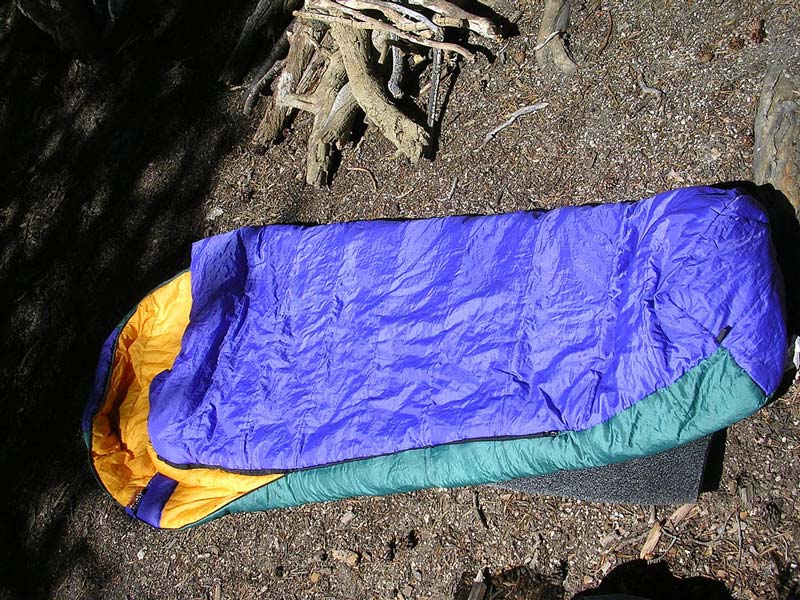As well as a tent, there a numerous other items which you will need to take with you on your camping trip.
Sleeping bags
Sleeping bags range from high tech ones that can be used for extreme conditions, to simple and cheap bags that are suitable for the amateur camper. Down sleeping bags are more expensive, but they will last around two to three times longer than synthetic bags. The weight to warmth ratio is also extremely good; although you have to ensure that you keep the bag dry as once it is wet it will offer very poor insulation. The insulation capacity for down is measured in one ounce per cubic inch for the volume, so that bags with 600 to 650 fill are of excellent quality, with 900 being the best. Synthetic insulation does not compress as well, so does not provide as much warmth, but they are machine washable, and can withstand the damp better than down filled bags. Such insulations include Polarguard Delta, PrimaLoft PL2 and DuPont Thermalite. Ultralight shell fabrics are also available, most of which have a durable water-repellent coating produced by welding baffles to the surface of the bag rather than using stitching.
Five seasons are available; 1 is summer for around 5 degrees Celsius, 2 is spring/summer for around 0 degrees Celsius, 3 is spring/autumn for around -5 degrees Celsius, 4 is winter of around -10 degrees Celsius and 5 is expedition for around -15 degrees Celsius. These are somewhat arbitrary and therefore you should check with each specific bag what temperature they are for rather then just going by what season they are designed for.
Hoods add a great deal of warmth if needed, and will stop any drafts getting into the bag. Draft collars are usually only found on more specialist bags, to help any heat loss around the shoulders and stop any draft from getting in. Some bags include a draft tube behind the zip, which also acts as a draft insulator. If you have a zip which is full length, so that it unzips around the bottom of the bag as well as the side, then you can open this up for ventilation on warmer nights. The mummy-shaped bag offers the best heat retention and weight, but the smaller, thinner ones can often be tighter which can prove to be claustrophobic. If you are going to be sleeping in warmer conditions use a semi-rectangular bag, as this will give you more room to move around and let air circulate.
Sleeping bag accessories
Sleeping bag liners are a way of adding extra warmth in colder conditions if your sleeping bag is not designed for such temperatures. Liners are available in either cotton or silk-based fabrics, which also offer a more pleasant alternative to the inside of some sleeping bags, or micro fleece thermal fabrics, which offer added insulation. They are usually mummy-shaped, and offer a snug fit. If the weather is warmer than expected then the liner can also be used as an alternative to a sleeping bag. Liners are also designed to keep your bag clean, as they are easier to wash than sleeping bags. This is especially useful for trekking holidays when you are likely to get pretty dirty throughout the holiday.
Travel sheets are similar to sleeping bag liners but are rectangular-shaped and have a side opening which is joined with Velcro. They also usually contain a pillow pocket. Travel sheets are used for exactly the same purposed as sleeping bag liners.
Coupler are available which can be attached to your normal sleeping bag by the zip to make it into a bag which fits two. Either summer or winter couplers are available according to the type of sleeping bag you have available and the conditions you are camping in. Couplers work best with hoodless sleeping bags.
Travel Pillows
Travel pillows can either be used loose, or fit into the pillow pocket which is built into your travel sheet. These are compact and lightweight, with the cover fabric usually being made from a combination of cotton and silk. Synthetic fill is typically used, as this compacts down and can easily be stored in a small space.
Mats
Sleeping mats serve two purposes: they insulate you from cold from the ground, and they provide you with a cushion to sleep on. Roll mats are the most common type of bedding that is used, as these are cheap and reasonably durable and can be folded down into a small size. However, these foam boards do take up quite a lot of room when laid out and therefore are often not suitable for trekking holidays or if you do not have a great deal of space. Inflatable mats are also available, either in single or double sizes. These are made from plastic fabrics and are blown up using either a foot or automatic pump. These mats are much more comfortable, but because of their size can only be used in larger tents and are only suitable for camping trips that have the option of taking lots of equipment.
Sleeping bag heaters
Sleeping bag heaters are emergency equipment that can be used if the temperature turns out to be much colder than expected. Once they are removed from their packet the air instantly activates their heat, which lasts for up to 12 hours if in an enclosed area. The heater’s temperature reaches around 40 degrees Celsius (they can be wrapped in a cloth if you think that this is too hot). They can only be used once.
Backpacks
There is a vast array of backpacks available, catering for every travelling need. Backpacks are measured in litres, using ranging from around twenty litres at the smallest to ninety at the largest.
More:
Originally written for Talkcamping.co.uk
Photo by Smack – Own work, Public Domain, https://commons.wikimedia.org/w/index.php?curid=1078412

